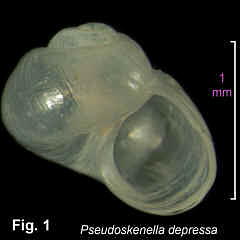|
|
PYRAMIDELLIDAE |
|
|
|
Pseudoskenella depressa Ponder, 1973 Description: Shell very small, low-spired, up to 2 teleoconch whorls. Protoconch (Type C) of 1¼ whorls, first half whorl infolded. Teleoconch whorls strongly rounded, without sculpture. Aperture wide, oblique, outer lip simple, not thickened, inner lip slightly reflected outwards; columella without plait. Umbilicus open, narrow to moderately wide. Shell translucent becoming opaque white with age. Size: Up to 1.5 mm in height. Distribution: Endemic to Australia: southern Qld, southwards and around southern Australia, to south-western WA, including Tas. Habitat: This species feeds on the tube worm Galeolaria caespitosa, the tubes of which form dense masses in the middle and lower intertidal levels in NSW. Individuals position themselves around the opening of the tube or on the worm's operculum. When the worm extends it pinnules (fronds) to feed, the mollusc extends its proboscis and sucks fluid from the worm. (Ponder, 1973). Comparison: No other NSW pyramidellid approached this in shell form. The most similar NSW species is Cornirostra pellucida (Laseron, 1954), in the Cornirostridae, which is larger with a wider umbilicus. Remarks: The shell, external morphology of the animal, habitat and feeding were described by Ponder (1973). Fig. 1: Long Reef, Collaroy, Sydney (C.341792). |
|
